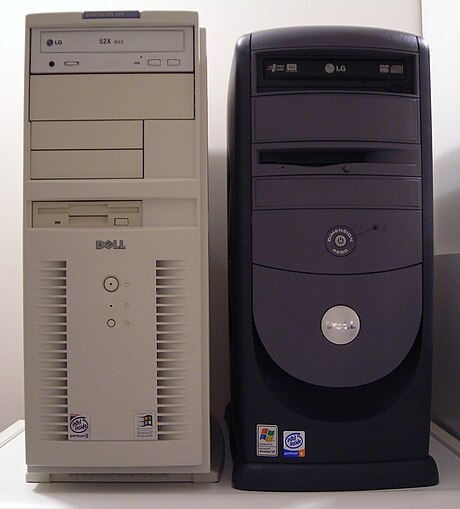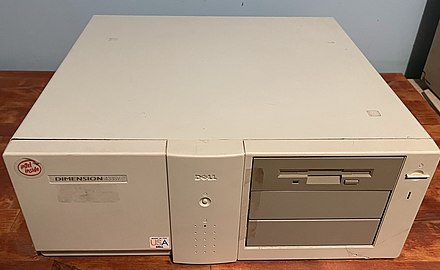
The Dell Dimension series was a line of home and business desktop computers manufactured by Dell. In 2007, the Dimension series was discontinued and replaced with the Dell Inspiron series for low-end models and the Dell Studio series for higher-end models.
The last high-end computers to be released under the Dimension line were the 9200 and 9200c (XPS 410 and XPS 210 in the American market, respectively). The E520, E521 and C521 were re-introduced under the Inspiron line under the names Inspiron 530, 531, 530s and 531s, with a revised case design.

The Dell Dimension E521 represents the entry point for Windows Vista Home Premium. Sure you could run that Vista edition with less (1GB instead of 2GB, single core instead of dual core), but in my opinion, this E521 is the effective minimum configuration to keep you computing in good stead for the next few years. With the introduction of more programs that take advantage of Vista's new features, and with the extra add-ons like Vista Gadgets and (missing) security software, you'll need the future-proofed features if you're the type of user (beginning multimedia enthusiast or budding power user) who wants Vista Premium instead of Vista Home Basic.
The Dimension E521 comes in Dell's standard mid-tower BTX case, with room for a couple of hard drives, a couple of optical drives, expansion cards, and memory. It's got the standard Dell level of tool-less upgradeability: you don't need to turn a screwdriver to add memory, an extra drive, or PCI or PCIe expansion card. Not that the system requires anything else: the E521 I tested came with a discrete ATI Radeon X1300 Pro graphics card, though the system can accommodate more powerful enthusiast graphics cards, too. You could argue for a higher-powered graphics card or a TV tuner, but these components cost extra, and I'm not sure if they're necessary on a basic midrange PC.
Last year, finding an AMD processor in a Dell would've been notable, now it's routine. The E521's AMD Athlon 64 X2 3800+ processor is a decent midrange dual-core processor. Along with the ATI Radeon X1300 Pro graphics, it's more than powerful enough to run Vista in full-blown Aero mode. Day-to-day activities like web browsing and casual games were snappy and performance was as expected. The E521 came with 2GB of memory, which is plenty for even multimedia tasks like video encoding and photo editing. Gamers and professional users may want to upgrade to 4GB or more, but mere mortals should be able to run with 2GB. The E521's 160GB SATA hard drive is good for a mainstream system, and you can add DataSafe for about $80 extra. (DataSafe adds another 160GB hard drive as a live backup.

Developer: Dell, Type: Desktop computer, Release date: 1993, Discontinued: April 9, 2007, CPU: AMD, Intel Celeron, Intel Pentium, Intel Core, Graphics: Intel Extreme Graphics, Intel GMA, ATI/AMD Radeon, NVIDIA GeForce, Successor: Dell Inspiron (desktops), Related: Dell Inspiron, Dell Vostro, Dell XPS, Website: Wikipedia

In its lifespan from 2001 to 2007, Nintendo licensed over 600 GameCube games.[81][82] Nintendo bolstered the console's popularity[83] by creating new franchises, such as Pikmin and Animal Crossing, and renewing some that had skipped the Nintendo 64, such as with Metroid Prime. Longer standing franchises include the critically acclaimed The Legend of Zelda: The Wind Waker and Super Mario Sunshine, and the GameCube's best-selling game, Super Smash Bros. Melee, at 7 million copies worldwide. Other Nintendo games are successors to Nintendo 64 games, such as F-Zero GX; Mario Golf: Toadstool Tour; Mario Kart: Double Dash; Mario Party 4, 5, 6, and 7; Mario Power Tennis; and Paper Mario: The Thousand-Year Door. Though committed to its software library, Nintendo was still criticized for not releasing enough launch window games and by the release of Luigi's Mansion instead of a 3D Mario game.
Nintendo had struggled with its family-friendly image during the late 1990s and most of the 2000s. However, during this period, it released more video games for a mature audience with mostly successful results.[84][85][86][87] While the video game industry was focusing on more mature audiences and online connections, Nintendo regained older players who had gravitated to the PlayStation 2 and Xbox during the early 2000s.[88][89] Some games aimed at older audiences were critically and financially successful—more than on Dreamcast, and less than on PlayStation 2 and Xbox.[90] Such examples include The Legend of Zelda: Twilight Princess,[91][92] Super Smash Bros. Melee,[93][94] Resident Evil 4,[95][96][97][98] Metal Gear Solid: The Twin Snakes,[99][100] Killer7,[101] Star Wars Rogue Squadron II: Rogue Leader,[102] Final Fantasy Crystal Chronicles,[103][104] Resident Evil (2002),[105] Metroid Prime,[106] Metroid Prime II: Echoes,[107] Soul Calibur II,[90] Resident Evil Zero,[108] F-Zero GX,[109] Star Fox Adventures,[90] and Star Fox Assault.[110] One of the most well-known GameCube games for mature audiences is Eternal Darkness: Sanity’s Requiem, which underperformed financially, but garnered critical acclaim and is now regarded as a cult classic.[111][112][113][114]

The Dell Dimension series was a line of home and business desktop computers manufactured by Dell. In 2007, the Dimension series was discontinued and replaced with the Dell Inspiron series for low-end models and the Dell Studio series for higher-end models.
The last high-end computers to be released under the Dimension line were the 9200 and 9200c (XPS 410 and XPS 210 in the American market, respectively). The E520, E521 and C521 were re-introduced under the Inspiron


